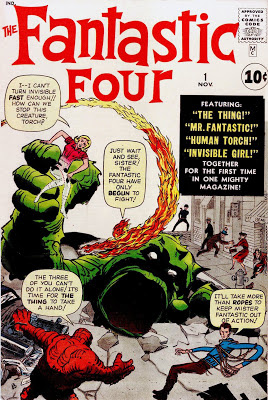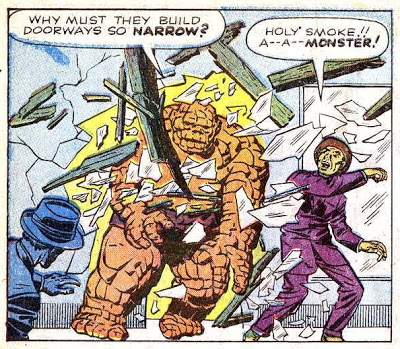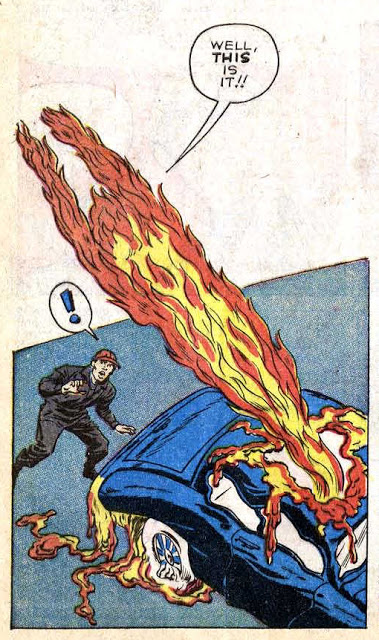One of the greatest guides to the concept of continuity in a specific series is The DisContinuity Guide: The Unofficial Doctor Who Companion by Paul Cornell, Martin Day and Keith Topping, first put out in 1995. From my point of view the genius of this work is in the way the authors peel back the layers of a complex text like Doctor Who, and start back at the beginning, when we didn’t know anything about the series or what it would eventually evolve into.
This allows us to see the ways in which the universe was expanded, sometimes carefully, often times not. We get to see undeveloped themes and the earliest examples of new themes.
Like an evolutionary biologist studying our small, brown furred burrowing human ancestors, we get a look at the way things were without the baggage of the way things are.
In a series of posts I hope to look at Marvel Comics the same way.
The “Marvel Universe” is the place where all the various superheroes and villains of Marvel Comics live, die, come back to life and have adventures. The Marvel Universe is, at its core, a concept invented by Stan Lee, Jack Kirby, Steve Ditko and other comic legends as a way to sell more comics.
If you love the Fantastic Four, did you know that their pal Spider-Man lives in the same world?
A shared continuity does more than just sell more comics, though, it allows creators to share ideas and concepts, building on the best of the past while creating startling new stories.
Today Marvel’s continuity is often seen by the current crop of creators as a limitation, and is, as often as not, ignored.
Weirdly, I’m fine with that. It’s the job of comics creators to produce good stories.
It’s the job of obsessive nutcase fans to be concern themselves with continuity.
Marvel Comics Silver Age DisContinuity 001
Title(s):
The Fantastic Four!
The Fantastic Four Meet the Mole Man!
The Mole Man’s Secret!
Publication Date/On Sale Date:
November 1961/August 1961
Writer/Artists:
Stan Lee, Jack Kirby
Sources:
Marvel Monster Comics, Justice League of America, Superman and the Mole Men, Challengers of the Unknown, Plastic Man, Human Torch, King Kong, A Journey to the Center of the Earth (novel), The Invisible Man, Flexo the Rubber Man, the Elongated Man, Elastic Lad, Invisible Scarlet O’Neil, Doc Savage, Yuri Gargarin
No Prizes :
6-1 The Thing bursts through a doorway when leaving a men’s clothing
shop, complaining that the doors are too narrow. This leads one to
wonder how The Thing got into the store in the first place. The Thing
then proceeds to go on a rampage of destruction for no real reason.
8-4 Is it necessary for The Human Torch to melt the car, rather than step away before flaming on?
Why does Reed Richards, a scientist, and Ben Grimm, a pilot, think it is okay to bring along Reed’s girlfriend Sue and her kid brother Johnny along on their ride on a spaceship? Can anyone imagine Buzz Aldrin bringing along his wife and kids when he went to the moon?
Quotes:
Reed: Listen to me, all of you! That means you too, Ben. Together we have more power than any humans have ever possessed!
Ben: You don’t have to make a speech, big shot! We understand! We’ve gotta use that power to help mankind, right?
Reed: Right, Ben, Right!
Continuity:
Introduction and first appearance of Benjamin “Ben” Grimm aka The Thing, Reed Richards aka Mr. Fantastic, Susan Storm aka The Invisible Girl, Johnny Storm aka The Human Torch and the Moleman.
Unprotected exposure to cosmic rays can give people superpowers.
The scene depicted on the cover of the book never happens in the comic. When the giant monster erupts out of the ground, it is in the lair of the Moleman that it occurs, not on some busy street in an American city.
Links :
The monsters discovered and controlled by the Moleman are a direct link to the seemingly endless series of monster comics Marvel was churning out. As Ed Sanchez points out in Give My Creation Life!, “Many characters that would go on to play significant roles in the super-hero titles had early try-outs within the pages of some of these books. Depending upon your point of view, these stories can be seen as either early try-outs or prototypes, or just pure coincidence.”
The Moleman’s explanation of his bat-like radar sense will be used again when we meet Daredevil in 1964.
The Human Torch would at first seem like a direct nod to the earlier Timely/Atlas version of the character, but Johnny Storm is completely unrelated to this earlier version. In fact, he calls himself the Human Torch and for his entire early career no one mentions the existence of an earlier Human Torch. Johnny comes up with the name in this issue seemingly off the top of his head.
Location:
Central City – The early issues of Fantastic Four were not yet entirely set in the “real world” of New York as later issues would suggest. Instead, we meet the team in the fictional Central City.
Outer Space – We are introduced to the dangerous “cosmic rays” that give the FF their powers.
Monster Isle – Though The Thing says the island is a myth, it turns out to exist a few hours away from Central City by jet. At the end of the issue Monster Isle is completely destroyed in what appears to be an atomic blast.
Reed Richards mentions several other places, establishing that the Marvel Universe is quite a bit like our own. There is mention of the “Iron Curtain,” which is the location of the former Soviet Union and its various satellite countries. Sue seems most concerned with getting people into space “unless we want the commies to beat us to it!” Australia and South America get a mention. There is an extended scene of a monster attack on nuclear plant that takes place in “French Africa” on pages 20-21.
When telling his story, The Moleman is seen wandering a frozen wasteland and discovering a cave to the inner Earth, a clear parallel to A Journey to the Center of the Earth.
Bottom line :
When Fantastic Four hit the stands in the summer of 1961, it was Marvel re-entering a genre they had given up on for almost a decade, Superheroes.
Take a look at the other comics released by the company in August. Seven monster comics, seven teen/love story comics and two westerns (a dying genre at this time) made up the rest of Marvel’s line-up. Lee and Kirby entered the superhero genre carefully, doing a story that wasn’t a great departure from the other monster comics the company was putting on the stands at the time.
A casual, monster-obsessed reader would have no trouble picking up Fantastic Four because it was a monster book first, and a superhero book secondly.
Also, Lee and Kirby borrowed heavily from many sources. The Human Torch was a popular character for Timely throughout the 1940s. Notably, no one mentions the existence of a previous Human Torch. From this we can infer that the Fantastic Four are not necessarily in the same universe as the older Timely superheroes, though very soon we will learn that they are.
Mr. Fantastic’s stretching powers hearken back to Quality Comics’ Plastic Man, DC Comic’s the Elognated Man and Jimmy Olson’s sometime secret identity as Elastic Lad and Timely had a short-lived superhero called Flexo the Rubber Man in the early 1940s.
The Thing is a monster straight out of Marvel’s endless monster comics and the Invisible Girl’s powers are at least as as old as H.G. Wells, though Invisible Scarlet O’Neil could be seen as a predecessor in comics.
Lee has mentioned the popularity of the Justice League of America for getting his publisher interested in doing superhero comics again, and Jack Kirby has pointed out the similarity between the Fantastic Four and a series he developed for DC Comics called The Challengers of the Unknown. Lee also later admitted being influenced by Doc Savage pulps and the spaceflight of Yuri Gargarin. I should also point out that Archie Comics had recently entered the superhero market themselves with the series The Adventures of the Fly and The Adventures of the Jaguar. The superhero genre was dominated and covered by DC Comics, which consistently published Wonder Woman as well as the Batman and Superman family of comics. They were expanding their superhero lines with Flash, Green Lantern and the Atom, and having great success.
Fantastic Four was completely different from every other superhero comic on the shelf. In fact, based on the first issue, with the team’s lack of costumes and seeming disinterest in fighting crime, it is debatable as to whether or not this first issue was about superheroes at all.
Additional insights and comments are welcome.













































































































2 Comments